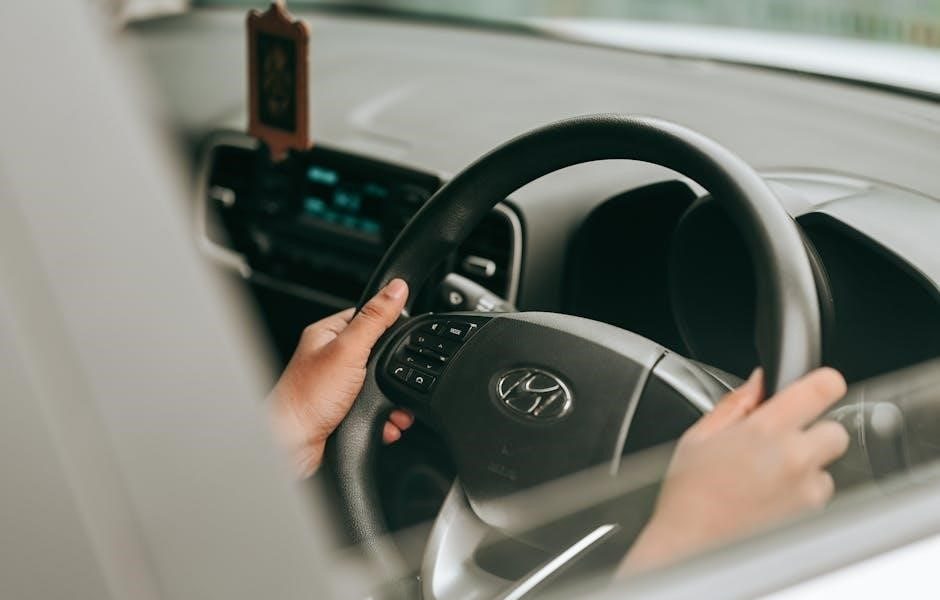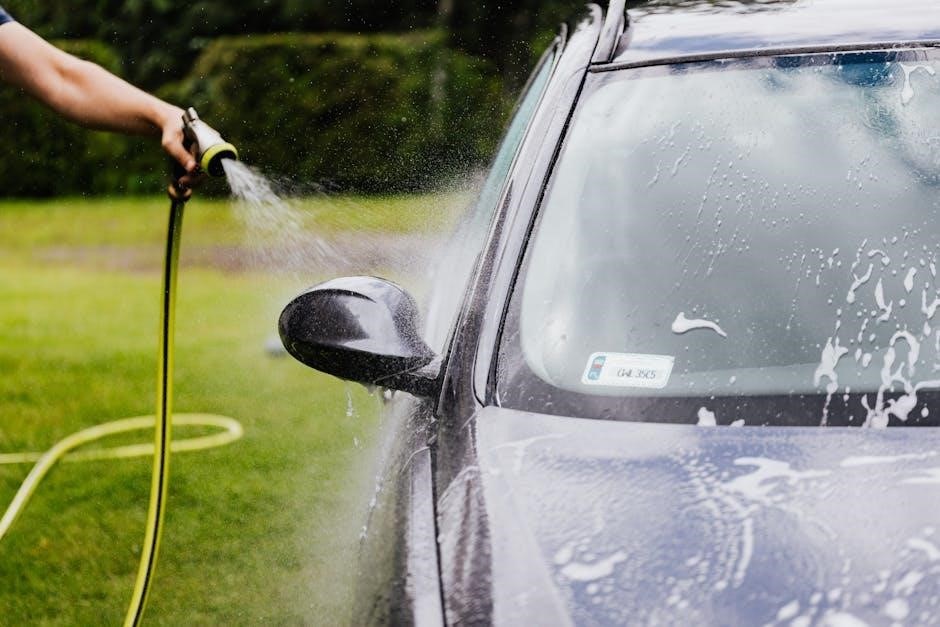
washington driver’s manual
The Washington Driver’s Manual, provided by the Washington State Department of Licensing, serves as the official guide for drivers, detailing traffic laws, safe practices, and licensing processes.
1.1 Overview of the Manual
The Washington Driver’s Manual is an essential resource for drivers, providing detailed information on traffic laws, road signs, and safe driving practices. It is divided into clear chapters, each focusing on specific aspects of driving, such as rules of the road, license requirements, and vehicle maintenance. The manual is designed to be user-friendly, ensuring drivers can easily understand and apply the information. Regularly updated by the Washington State Department of Licensing, it reflects the most current laws and regulations. Whether you’re a new driver or an experienced one, the manual serves as a comprehensive guide to help you navigate Washington’s roads safely and legally. Its structured format makes it an invaluable tool for preparing for driver’s tests and staying informed about driving best practices.
1.2 Importance for Drivers
The Washington Driver’s Manual is a crucial resource for all drivers, ensuring they understand traffic laws, road signs, and safe driving practices. It provides essential information for obtaining a driver’s license, detailing the requirements and processes. The manual also serves as a reference for experienced drivers to refresh their knowledge and stay updated on new laws. By studying the manual, drivers can reduce the risk of accidents and ensure compliance with state regulations. It is particularly vital for new drivers, as it prepares them for the written and driving tests. The manual’s clear and concise content helps drivers develop responsible habits, contributing to safer roads and communities across Washington.
Purpose and Importance of the Driver’s Manual
The Washington Driver’s Manual is a guide for understanding traffic laws, safe practices, and licensing processes, ensuring drivers are informed and compliant with state regulations.
2.1 Role in Driver Education
The Washington Driver’s Manual plays a crucial role in driver education by providing a comprehensive guide for new and experienced drivers. It outlines traffic laws, road signs, and safe driving practices, serving as the primary resource for understanding state-specific regulations. The manual is designed to help individuals prepare for the driver’s license test, ensuring they are well-informed about the rules of the road; Additionally, it emphasizes defensive driving techniques and the importance of adhering to traffic laws to promote road safety. By studying the manual, drivers can gain the knowledge and confidence needed to operate a vehicle safely and responsibly in Washington State.
2.2 Legal Requirements
The Washington Driver’s Manual outlines the legal requirements for obtaining and maintaining a driver’s license in the state. It details the necessary documentation, such as proof of identity, residency, and legal status, which must be submitted to the Department of Licensing. The manual also covers the legal age requirements for drivers, with specific provisions for minors and older adults. Additionally, it explains the consequences of violating traffic laws, including fines, license suspension, and other penalties. Understanding these legal requirements is essential for drivers to comply with state regulations and avoid legal repercussions. The manual serves as a key resource for ensuring that all drivers operate within the bounds of Washington State law.

Eligibility Requirements for a Driver’s License in Washington
Eligibility for a Washington driver’s license requires meeting specific age, residency, and legal status criteria, ensuring applicants qualify under state regulations to obtain driving privileges.
3.1 Age and Residency Requirements
In Washington, driver’s license eligibility begins at specific ages, with teens typically qualifying at 16 under a graduated license system, while full privileges are granted at 18. Adults and seniors must also meet residency criteria, proving they are Washington state residents through documents like utility bills or lease agreements. These requirements ensure applicants are legally permitted to drive within the state, adhering to age and residency guidelines set by the Washington State Department of Licensing. Proper documentation is essential to verify eligibility, ensuring compliance with state laws and road safety standards.
3;2 Documentation Needed
To apply for a driver’s license in Washington, specific documentation is required to verify identity, residency, and Social Security status. Applicants must provide proof of identity, such as a valid passport or birth certificate, and two documents confirming residency, like utility bills or a lease agreement. Additionally, proof of Social Security, such as a Social Security card or W-2 form, is mandatory. The Washington State Department of Licensing outlines these requirements to ensure compliance with federal and state regulations. All documents must be valid and unexpired to be accepted; Forms and detailed lists of acceptable documents are available on the official DOL website, ensuring applicants can prepare accurately before visiting a licensing office.

Types of Driver’s Licenses in Washington
Washington offers various driver’s licenses, including regular, learner’s permits, and commercial driver’s licenses (CDLs). Each type serves specific needs, ensuring safe and legal driving privileges statewide.
4.1 Regular Driver’s License
A regular driver’s license in Washington allows individuals to operate passenger vehicles. It is issued to residents who meet age, residency, and documentation requirements. Applicants must pass vision, knowledge, and driving tests. The license is renewable every six years. It serves as a valid form of identification and is essential for legal driving within the state. The Washington State Department of Licensing ensures that all applicants adhere to strict guidelines to maintain road safety. This license type is the most common and is a crucial step toward independent driving privileges.
4.2 Special Licenses (Learner’s, CDL, etc.)
Washington offers various special licenses to cater to different driving needs. A Learner’s License is issued to new drivers, typically teenagers, allowing them to practice under supervision. Commercial Driver’s Licenses (CDLs) are required for operating heavy vehicles, buses, or hazardous material transport. Applicants must meet specific medical and training standards. Endorsements for CDLs include passenger transport, tank vehicles, and doubles/triples trailers. Other specialized licenses include motorcycle endorsements and farm vehicle permits. Each type has unique eligibility criteria and testing requirements. The Washington State Department of Licensing ensures that these licenses are issued only to qualified individuals, promoting road safety and compliance with federal regulations. These licenses are essential for drivers needing specialized privileges beyond a regular license.
Structure and Content of the Washington Driver’s Manual
The Washington Driver’s Manual is a comprehensive guide divided into chapters and sections, covering traffic laws, road signs, safe driving practices, and licensing requirements, regularly updated for accuracy.

5.1 Chapters and Sections
The Washington Driver’s Manual is organized into clear chapters and sections, ensuring easy navigation. It begins with an overview of driving laws and progresses through topics like road signs, traffic signals, and safe driving techniques. Each chapter is divided into subsections, addressing specific aspects such as speed limits, right-of-way rules, and special conditions like nighttime or inclement weather driving. The manual also includes dedicated sections for new drivers, emphasizing the importance of learner’s permits and supervised practice. This structured approach ensures that all essential information is covered comprehensively, making it an invaluable resource for both new and experienced drivers seeking to understand Washington’s driving regulations.
5.2 Key Topics Covered
The Washington Driver’s Manual covers essential topics to prepare drivers for safe and legal operation of vehicles. Key areas include traffic laws, such as right-of-way rules and speed limits, as well as defensive driving techniques to minimize accidents. The manual also addresses special driving conditions, like rain, snow, and nighttime driving, providing tips for increased visibility and control. Additionally, it outlines the consequences of driving under the influence (DUI) and other traffic violations, emphasizing the importance of responsible behavior behind the wheel. Vehicle registration and maintenance requirements are also discussed, ensuring drivers understand their obligations to keep their vehicles roadworthy. These topics collectively provide a comprehensive foundation for drivers in Washington State.
Rules of the Road in Washington
Washington’s driver manual outlines traffic laws, safe driving practices, and regulations to ensure road safety, covering speed limits, right-of-way rules, and proper vehicle operation.
6.1 Traffic Laws
Washington’s traffic laws are designed to promote road safety and order. The driver’s manual details regulations such as speed limits, right-of-way rules, and prohibited maneuvers. Drivers must adhere to posted speed limits, which vary by location, such as school zones and highways. Right-of-way rules govern interactions at intersections and with pedestrians. Prohibited actions include reckless driving, tailgating, and failing to yield. The manual also covers specific laws like mandatory seatbelt use and restrictions on handheld device usage while driving. Violations of these laws can result in fines, penalties, or license suspension. Understanding and following these traffic laws is essential for safe and legal driving in Washington.
6.2 Speed Limits
Speed limits in Washington are established to ensure safety on the roads. The driver’s manual outlines maximum speeds for various areas, such as urban zones, school zones, and highways. Urban areas typically have a 25-35 mph limit, while highways may allow up to 70 mph. School zones often have reduced limits during specific hours. Speed limits are enforced to protect all road users, including pedestrians and cyclists. Drivers must adjust their speed according to road conditions, such as rain, fog, or construction. Exceeding speed limits can result in fines and penalties. The manual emphasizes the importance of obeying posted signs and adjusting speed for safety, even if the limit is higher than necessary for current conditions.
Safe Driving Practices
Safe driving practices in Washington emphasize staying alert, following traffic laws, and maintaining a safe distance. Adjust speed for road conditions and avoid distractions like phone use.
7.1 General Safety Tips
General safety tips in the Washington Driver’s Manual emphasize staying alert and focused while driving. Avoid distractions like using a phone or eating. Always maintain a safe distance from other vehicles and adjust speed according to road conditions. Use seat belts and ensure all passengers are buckled up. Be aware of surroundings, including pedestrians, cyclists, and large vehicles. Keep headlights on in low visibility and use signals consistently. Regular vehicle maintenance, such as checking tire pressure and brakes, is crucial for safety. Follow traffic laws and be cautious in school zones or construction areas. Defensive driving practices, like anticipating others’ actions, can prevent accidents. Stay patient and courteous to promote a safe driving environment for everyone on the road.
7.2 Defensive Driving
Defensive driving is a proactive approach to staying safe on the road by anticipating potential hazards and reacting appropriately. The Washington Driver’s Manual emphasizes strategies like maintaining a safe following distance, staying alert to blind spots, and being prepared for unexpected actions by other drivers. It’s crucial to avoid assumptions about other drivers’ intentions and to remain calm in aggressive driving situations. Defensive driving also involves adjusting speed according to road conditions, such as reducing speed in rain or fog. Using mirrors and signals consistently helps communicate intentions to other drivers. By adopting these practices, drivers can significantly reduce the risk of accidents and enhance overall road safety. Defensive driving is not just a skill—it’s a mindset that prioritizes caution and awareness.
Obtaining a Driver’s License
Obtaining a driver’s license in Washington involves meeting eligibility requirements, preparing necessary documents, and completing mandatory tests, as outlined in the official driver’s manual.
8.1 Application Process
To apply for a driver’s license in Washington, visit a Department of Licensing office with required documents, such as proof of identity, residency, and legal presence. Submit a completed application form and pay the applicable fees. A vision test is typically required, and applicants under 18 must provide parental consent. Once the application is processed, applicants will take a written knowledge test to assess their understanding of traffic laws and safe driving practices. Upon passing, they will receive an instruction permit, which allows them to practice driving under supervision. The process ensures compliance with state regulations and prepares applicants for safe and responsible driving.
8.2 Tests Required
In Washington, obtaining a driver’s license involves passing several tests to ensure driving competence. The vision test assesses visual acuity and peripheral vision. The written knowledge test, based on the driver’s manual, covers traffic laws, road signs, and safe driving practices. Applicants must answer correctly to proceed. For driver’s skills assessment, a behind-the-wheel test evaluates vehicle control, adherence to traffic rules, and ability to navigate various road conditions safely. These tests are designed to verify that applicants possess the necessary knowledge and skills to operate a vehicle responsibly. Passing these tests is mandatory for licensing, ensuring public safety on Washington’s roads.

DUI and Traffic Violations
Washington strictly enforces DUI laws, with penalties including fines, license suspension, and ignition interlock requirements. The legal BAC limit is 0.08%, and violations result in severe consequences.

9.1 DUI Laws
In Washington, driving under the influence (DUI) of alcohol or drugs is a serious offense. The legal blood alcohol content (BAC) limit is 0.08%. Penalties for a first offense include fines, license suspension, and mandatory installation of an ignition interlock device. Repeat offenses result in harsher penalties, including longer license suspensions and increased fines. Refusal to submit to a BAC test can lead to automatic license suspension. DUI convictions remain on a driver’s record for at least five years and can significantly increase insurance rates. Additionally, DUI charges may lead to criminal penalties, including jail time. The Washington Driver’s Manual emphasizes the importance of adhering to these laws to ensure public safety and avoid severe legal consequences.
9.2 Penalties for Violations
Violating traffic laws in Washington can result in severe penalties, including fines, license suspension, and even criminal charges. For minor infractions, such as speeding or failing to stop at a stop sign, drivers may receive fines and points on their driving record. Accumulating too many points can lead to license suspension. More serious offenses, such as reckless driving or hit-and-run incidents, carry higher fines, mandatory community service, and potential jail time. Repeat offenders may face increased penalties, including longer license suspensions and higher fines. In addition, some violations may require the installation of an ignition interlock device or attendance in a traffic safety course. These penalties aim to promote road safety and deter future violations.

Vehicle Registration and Maintenance
Vehicle registration and maintenance are crucial for legal operation in Washington. The process involves submitting required documents, paying fees, and ensuring your vehicle meets safety and emissions standards.
10.1 Registration Process
Registering your vehicle in Washington involves several steps. First, obtain the necessary forms from the Washington State Department of Licensing or download them online. You will need proof of ownership, such as a title or manufacturer’s certificate of origin, and valid insurance. Additionally, you must provide a vehicle identification number (VIN) verification if the vehicle is from out of state. Fees vary based on the type of vehicle and its value. Some counties may require emissions testing. Once all documents and fees are submitted, either in person, by mail, or online, your vehicle will be registered, and you will receive your license plates and registration stickers.

10.2 Maintenance Requirements
Regular vehicle maintenance is crucial for safety and compliance in Washington. Drivers must ensure their vehicles meet state emissions standards, which may require periodic inspections. Tires should be properly inflated, and brakes must function correctly. Windshields and wipers must be in good condition to maintain clear visibility. Lights, including headlights, brake lights, and turn signals, must be operational. Vehicles are also subject to periodic safety inspections, especially if issued a citation. Failure to maintain your vehicle can result in fines or registration denial. It is recommended to follow a routine maintenance schedule, including oil changes and tire rotations, to prevent issues and ensure your vehicle remains roadworthy. Proper maintenance not only avoids penalties but also enhances safety on Washington roads.

Washington State Department of Licensing
The Washington State Department of Licensing (DOL) is the official government agency overseeing driver’s licenses, vehicle registrations, and related services, ensuring compliance with state laws and regulations.
11.1 Role and Responsibilities
The Washington State Department of Licensing (DOL) is responsible for issuing driver’s licenses, managing vehicle registrations, and maintaining driver and vehicle records. It ensures compliance with state driving laws, provides updated resources like the driver’s manual, and oversees licensing processes. The DOL also handles applications, renewals, and suspensions, while enforcing traffic safety standards. Additionally, it offers online services for convenience, such as renewing licenses and accessing forms. The agency plays a crucial role in maintaining road safety and efficiently managing transportation-related services across Washington State.
11.2 Contact Information
The Washington State Department of Licensing (DOL) can be reached through their official website at www.dol.wa.gov. For general inquiries, call (360) 902-3900 or visit their office at 1125 Washington St. SE, Olympia, WA 98504. Office hours are typically Monday through Friday, 8:30 AM to 5:00 PM. Appointments can be scheduled online for convenience. The DOL also provides email support for specific services. For driver’s license or vehicle registration questions, contact them via phone or visit their website for detailed guidance and resources. This ensures efficient assistance for all driver-related needs in Washington State.

Resources and Study Aids
The Washington Driver’s Manual is supported by online resources, including practice tests and study guides, to help drivers prepare for exams and understand traffic laws effectively.
12.1 Online Resources
The Washington State Department of Licensing offers various online resources to aid in driver education. These include downloadable versions of the driver’s manual, interactive practice tests, and guides for both new and experienced drivers. Additionally, third-party websites provide supplementary materials such as video tutorials and mobile apps to enhance study efforts. These resources ensure that applicants have access to up-to-date information and can prepare effectively for their driver’s license exams. By utilizing these tools, individuals can gain a deeper understanding of traffic laws, safe driving practices, and licensing requirements, increasing their chances of success.
12.2 Practice Tests and Tips
Practice tests and study tips are essential tools for preparing for the Washington driver’s license exam. The official Washington Driver’s Manual is a key resource, but supplementary materials can enhance understanding. Online platforms offer practice tests that simulate real exam questions, helping applicants assess their knowledge. Tips include focusing on traffic laws, road signs, and safe driving practices. Studying consistently and reviewing missed questions can improve retention. Additionally, some resources provide video tutorials and interactive guides to make learning more engaging. Utilizing these tools ensures applicants are well-prepared and confident for their exams. By combining manual study with practice tests, individuals can achieve a comprehensive grasp of driving requirements in Washington.
Related Posts

full auto modification manual
Discover the ultimate full auto modification manual! Get expert tips, guides, and step-by-step instructions to enhance your setup. Start modifying today!

bls manual ebook
Discover the comprehensive BLS Manual Ebook, your go-to guide for mastering Basic Life Support techniques. Easy to understand and perfect for healthcare professionals.

proform 2000 treadmill manual
Get the most out of your workout! Download the ProForm 2000 treadmill manual for easy setup, troubleshooting, and maintenance tips.